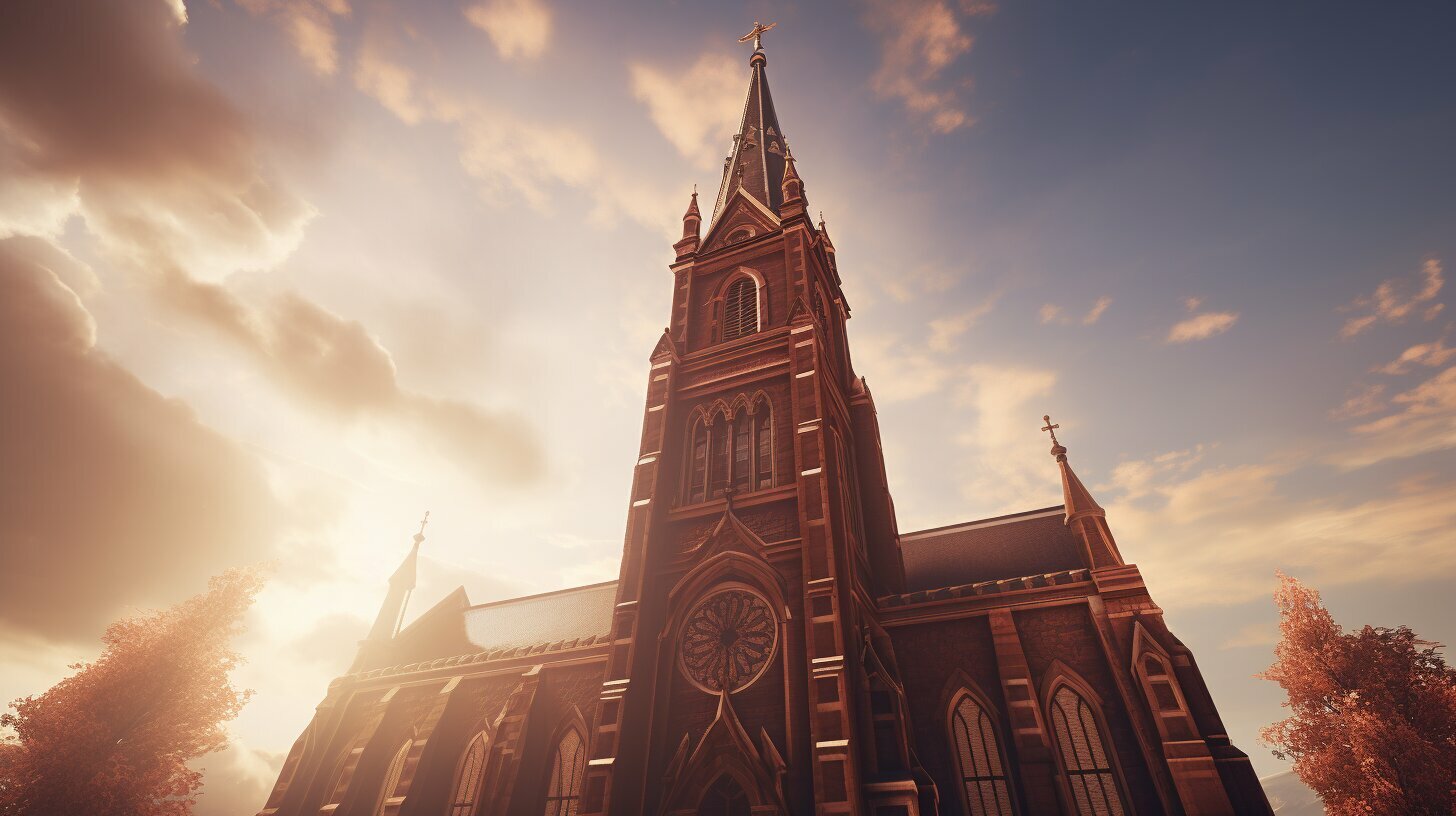Why Do Churches Have Steeples? Uncovering Heavenly Highs!
Steeples have been an iconic feature of churches for centuries, but have you ever wondered why they are such a prominent part of their architecture? These tall and majestic structures serve multiple purposes, carrying both historical significance and religious symbolism. They not only add beauty to church buildings but also hold cultural importance within communities. Let’s explore the various dimensions of church steeples and unravel their heavenly highs!
Key Takeaways:
- Church steeples have a long history and serve various purposes in Christian architecture.
- They originated from pagan worship of the sun god Ra, known as obelisks, but their use in churches is not considered pagan worship today.
- Steeples primarily serve as identifiers of church buildings and can feature crosses or other religious symbols, symbolizing faith towards God.
- They also act as landmarks in communities, helping people navigate their way and find Christian churches.
- Steeples add beauty and tranquility to church architecture, symbolically drawing our eyes heavenward and reminding us of a higher power.
The Origins of Steeples: Exploring Historical Significance
To understand why churches have steeples today, we must travel back in time to uncover their fascinating historical roots. Steeples have a long and intriguing history, with their origins dating back to ancient civilizations and religious practices.
In ancient Egypt, the worship of the sun god Ra gave rise to structures known as obelisks, which served as symbols of divine power and connection to the heavens. These tall, slender monuments were later adopted by the Roman Empire and can still be seen in cities like Rome and Paris today.
During the early Christian era, the use of steeples evolved from this ancient pagan practice. Steeples began to appear on churches as a way to distinguish these sacred spaces and to guide the faithful towards the house of God. Over time, steeples became a prominent feature of Christian architecture, serving as beacons of religious significance and landmarks within communities.
The Evolution of Steeples
As Christianity spread throughout Europe during the medieval period, steeples took on new forms and styles. Gothic architecture, with its soaring spires and intricate details, became synonymous with church design. The height of these steeples reached new heights, symbolizing the aspirational nature of faith and the desire to reach towards heaven.
Throughout history, steeples have also served practical purposes. They provided a platform for bell towers, allowing churches to announce the time and summon the faithful to worship. In times of danger or celebration, church bells would ring out, uniting the community and calling people to action.
Today, while the architectural styles of churches may have changed, steeples continue to be an integral part of Christian tradition and community identity. They stand tall and proud, reminding us of our shared history and faith, and serving as a physical symbol of the spiritual connection between heaven and earth.
| Key Points |
|---|
| Steeples originated from ancient Egyptian obelisks and were later adopted by the Roman Empire. |
| In Christianity, steeples began to appear on churches as a way to distinguish sacred spaces and guide the faithful. |
| Gothic architecture played a significant role in the evolution of steeples, with soaring spires and intricate details becoming prominent features. |
| Steeples served practical purposes such as providing a platform for bell towers and serving as landmarks within communities. |
| Today, steeples continue to symbolize the spiritual connection between heaven and earth, while also serving as reminders of our shared history and faith. |
Unraveling the Religious Symbolism of Steeples
Church steeples carry deep religious symbolism, serving as a spiritual reminder of faith and a connection to the divine. These towering structures, reaching towards the heavens, have long been an integral part of Christian architecture, conveying a powerful message to believers and onlookers alike.
Steeples, with their soaring heights, symbolize the desire to ascend higher towards God. They point us towards the divine realm, inspiring awe and reverence. Just as the physical structure of the steeple reaches upwards, so too does our faith, reaching towards the transcendent.
One of the most recognizable symbols often found atop steeples is the cross. This emblem serves as a testament to Christ’s sacrifice and the redemption that he offers. It is a visual reminder of the central teachings of Christianity and represents the hope and salvation found in Jesus Christ.
Furthermore, steeples can also feature other religious symbols, such as crosses, doves, or bells. These symbols hold their own unique meanings within the context of Christian tradition. Bells, for instance, not only serve a practical purpose in calling worshipers to prayer but also symbolize the call to salvation and the proclamation of the Gospel.
| Religious Symbol | Meaning |
|---|---|
| Cross | Symbol of sacrifice and redemption |
| Dove | Symbol of peace and the Holy Spirit |
| Bell | Symbol of calling to worship and proclaiming the Gospel |
As we gaze upon these towering structures, we are reminded of the divine presence in our lives and the enduring power of faith. The religious symbolism of steeples serves as a visual and spiritual reminder of our connection to God and our commitment to the teachings of Christianity.
The Architectural Purpose of Church Steeples
Church steeples not only add beauty and grandeur to the architectural landscape but also serve important purposes within the structure of church buildings. These towering structures are designed to fulfill both practical and symbolic functions, making them a significant feature of Christian architecture.
One of the primary architectural purposes of steeples is to provide a focal point, drawing the eyes of both worshippers and passersby towards the heavens. This vertical element serves as a visual reminder of the divine presence and the spiritual nature of the space. As I stand beneath a steeple, I am reminded of the timeless connection between earth and sky, and the awe-inspiring power of God.
Practical Functions of Church Steeples
Beyond their symbolic significance, steeples also serve practical functions within the structure of church buildings. These towering spires often house bells, which have historical and cultural significance within Christian communities. The resonant chimes of bells can mark significant moments in the life of a church, such as the call to worship, the celebration of joyous occasions, or the solemn tolling during times of mourning.
Additionally, steeples act as landmarks within communities, helping people locate Christian churches and navigate their way through unfamiliar surroundings. In a world filled with distractions, the sight of a steeple rising above the buildings serves as a guiding beacon, leading the faithful towards a place of solace and spiritual nourishment.
| Architectural Purpose | Practical Function |
|---|---|
| Symbolic reminder of the divine presence | Housing bells that mark significant moments |
| Focal point drawing the eyes towards the heavens | Serving as landmarks within communities |
“As I stand beneath a steeple, I am reminded of the timeless connection between earth and sky, and the awe-inspiring power of God.”
In conclusion, church steeples contribute to the architectural landscape of Christian buildings by adding beauty and grandeur. Beyond their aesthetics, steeples fulfill important practical and symbolic purposes. They serve as visual reminders of the divine presence, housing bells that play a significant role in Christian rituals and traditions. Moreover, steeples act as landmarks, guiding individuals to places of worship and offering a sense of direction in a chaotic world. So, the next time you gaze upon a steeple, let it be a reminder of both the practical and spiritual significance it holds within the architecture of a church building.
The Cultural Importance of Church Steeples
Church steeples have become synonymous with religious institutions, often standing as symbols of faith and community in our cultural consciousness. These iconic features grace the skylines of towns and cities, commanding attention and serving as beacons of spirituality.
Steeples have a profound impact on the cultural landscape, both aesthetically and symbolically. They add a touch of grandeur to the architectural composition of churches, elevating their presence in the community. The soaring heights and graceful shapes of steeples inspire a sense of awe and wonder, reminding us that there is something greater than ourselves.
It is in the cultural importance of steeples that we find a sense of belonging and identity. These towering structures not only mark the physical location of a church, but they also symbolize the values and beliefs of the congregation. Steeples serve as landmarks that guide individuals in their spiritual journey, offering a sense of comfort and familiarity amidst the hustle and bustle of daily life.
| Steeples in Cultural Context | Churches with Iconic Steeples |
|---|---|
| Steeples have been depicted in paintings, literature, and film, capturing their significance in shaping our cultural narrative. | Notable churches with iconic steeples include the Notre-Dame Cathedral in Paris, St. Peter’s Basilica in Vatican City, and the St. Patrick’s Cathedral in New York City. |
| They have been used as metaphors for reaching towards the divine, symbolizing hope, and representing the spiritual journey. | These churches attract visitors from all over the world who are drawn to the beauty and cultural significance of their steeples. |
Church steeples not only hold historical and architectural significance but also carry a deep cultural importance. They evoke a sense of tradition, community, and belonging, reminding us of our shared values and faith. As we look up to these heavenly heights, we are reminded of the enduring power of spirituality in our lives.
Looking Upwards: The Spiritual Significance of Steeples
As we gaze upon the towering steeples of churches, they beckon us to look beyond the physical realm and contemplate the spiritual realm above. These magnificent structures, with their soaring heights and intricate designs, hold a deep spiritual meaning that resonates with believers and non-believers alike.
The steeples of churches serve as a physical representation of our yearning for something greater than ourselves. They point skyward, reminding us of the divine presence that exists beyond the material world. Whether adorned with a cross or other religious symbols, steeples symbolize the direction of faith, drawing our attention to God and inviting us to connect with the sacred.
These graceful spires also have practical significance within church architecture. They act as visual landmarks, guiding us to the location of the church and serving as a beacon of hope and comfort. In communities both large and small, the presence of a steeple on the horizon brings a sense of familiarity and reassurance, reminding us that we are not alone in our spiritual journey.
Steeples add an element of beauty and tranquility to church buildings, enhancing their overall aesthetic appeal. Just as art has the power to uplift and inspire, these architectural marvels have a way of capturing our imagination and stirring our souls. By drawing our gaze heavenward, steeples remind us of the transcendent and eternal, helping us to transcend the challenges of our everyday lives.
| Did You Know? |
|---|
| Steeples are believed to have originated from pagan worship of the sun god Ra, where they were known as obelisks. However, the use of steeples in churches today is not seen as a form of pagan worship. |
In conclusion, the presence of steeples in churches holds a profound spiritual significance. They serve as powerful symbols of faith, guiding us towards the divine and reminding us of a higher power at work in our lives. Moreover, steeples add beauty and tranquility to church architecture, inspiring a sense of awe and wonder. So, let us continue to gaze upon these heavenly heights and embrace the spiritual significance that steeples bring to our lives.
Conclusion
Steeples in churches embody a rich tapestry of history, religious symbolism, architectural elegance, and cultural significance, making them an integral part of Christian heritage and identity.
Church steeples have a long and fascinating history, with their origins traced back to the worship of the sun god Ra in pagan cultures, where they were known as obelisks. However, in the context of Christianity, steeples are not seen as a form of pagan worship. Instead, they serve as a prominent feature that identifies a church building as a sacred space for worship.
One of the key purposes of steeples is to symbolize the direction of faith towards God. Many church steeples prominently feature crosses or other religious symbols, acting as a visual reminder of the spiritual journey and commitment to the divine. These symbols not only represent the Christian faith but also serve as beacons of hope and inspiration for believers.
In addition to their religious significance, steeples also serve practical purposes in communities. They act as landmarks, helping people navigate their way and locate Christian churches. Their towering presence adds beauty and tranquility to church architecture, creating a sense of awe and reverence. Steeples symbolically draw our eyes heavenward, reminding us of a greater power at work in our lives.
It is important to note that the presence of steeples in churches is not considered evil as long as they are used to glorify God and point to Him. They are invaluable elements of Christian heritage, carrying the weight of centuries of history, religious devotion, and cultural identity.
So, the next time you gaze upon a steeple reaching towards the sky, take a moment to appreciate the intricate connection it holds to the past, the present, and the spiritual journey of countless believers.
FAQ
Why do churches have steeples?
Churches have steeples for various reasons. They serve as a way to identify a church building as a place of worship and can feature crosses or other religious symbols, symbolizing the direction of faith towards God. Steeples also serve as landmarks in communities, helping people navigate their way and locate Christian churches. Additionally, steeples add beauty and tranquility to church architecture, reminding us of a greater power at work in our lives.
What is the historical significance of church steeples?
Church steeples have a long history, believed to have originated from pagan worship of the sun god Ra, where they were known as obelisks. However, the use of steeples in churches today is not seen as a form of pagan worship. They have evolved over time and become an integral part of Christian architecture, representing the connection between God and His people.
What is the religious symbolism of steeples?
Steeples hold religious symbolism for believers. They often feature crosses or other religious symbols atop them, representing the direction of faith towards God. The height of steeples also symbolizes the spiritual aspirations of Christians, pointing our eyes heavenward and inspiring a sense of awe and reverence.
What is the architectural purpose of church steeples?
Church steeples serve multiple architectural purposes. They contribute to the overall design of church buildings, adding verticality and grandeur. Steeples also provide a focal point for the eye, drawing attention to the church and symbolically guiding worshippers towards a place of spiritual significance.
What is the cultural importance of church steeples?
Church steeples have become iconic features of communities, shaping their cultural identity. They often serve as landmarks and are associated with the presence of Christianity in a particular area. Steeples hold historical and architectural significance, reflecting the heritage and values of a community.
What is the spiritual significance of steeples?
Steeples have a spiritual significance, drawing our gaze upwards and reminding us of a higher power. They inspire a sense of awe and wonder, symbolizing the connection between heaven and earth. Steeples serve as a visual reminder of the presence of God and His work in our lives.
- Discovering Why Do Women Wear Lipstick: A Deeper Look - 19/12/2023
- Why Do Golfers Only Wear One Glove? - 16/12/2023
- Why Don’t Hobbits Wear Shoes? - 14/12/2023
Hi, I’m Rhiannon, the lead author behind The News Wire. As a passionate journalist, I strive to bring you the latest news and updates from all over the world. With a keen eye for detail and a dedication to unbiased reporting, I aim to deliver well-researched and informative articles that keep you informed and engaged. From breaking news to in-depth analyses, I cover a wide range of topics with the aim of keeping you in the loop. Join me on The News Wire as we explore the dynamic and ever-changing landscapes of global events, uncovering the stories that matter most.






